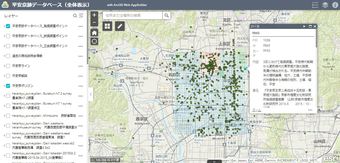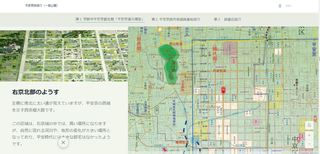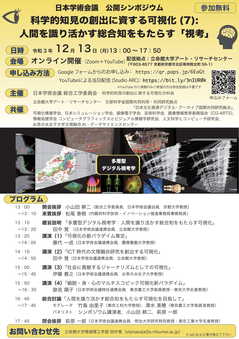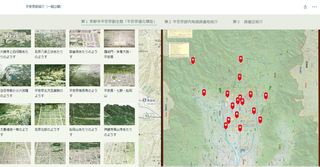-
 15
16
17
18
19
20
21
22
23
24
25
15
16
17
18
19
20
21
22
23
24
25
 [イベント情報]December 20, 2021(Mon)
[イベント情報]December 20, 2021(Mon)We are pleased to announce the Call for Manuscript Submissions for the Art Research Center's journal ART RESEARCH volume 22-2. The publication has been reborn as an online journal.
The purpose of the journal is to widely publicize the results of the research projects and activities conducted by the Art Research Center and its partner institutions and collaborative researchers. As an academic journal specializing in arts and culture, it has received many contributions from industry experts every year.
Since its establishment in 1998, the Art Research Center (ARC) has been selected for several national grants as a center of excellence for research in culture, art, and information science. In FY2019, the center assumed the role as the International Joint Digital Archiving Center for Japanese Art & Culture (ARC-iJAC) upon its accreditation by the MEXT as an International Joint Usage/Research Center. The ARC is highly regarded as a leading hub for the digital archiving of Japanese art and culture.
Our online journal will be published several times a year, and at the end of the fiscal year, a print booklet summarizing all contributions will be distributed..
By accepting manuscripts any time from now, we hope to greatly increase the submission opportunities for researchers.
We look forward to receiving your manuscript submission.
Read more>>[イベント情報]December 20, 2021(Mon)The video of the symposium Scientific Knowledge Generation facilitated by Visualization (7): 'Visual Thinking' that brings a Comprehensive Knowledge of Humanity to Life, organized by the Science Council of Japan in cooperation with the International Joint Digital Archiving Center for Japanese Art and Culture (ARC-iJAC), Art Research Center, is now available on YouTube.
Public Online Symposium (*held in Japanese)
The Science Council of Japan Presents:
Scientific Knowledge Generation facilitated by Visualization (7): 'Visual Thinking' that brings a Comprehensive Knowledge of Humanity to Life
<<Registration closed >>
Date: December 13 (Monday), 2021 13:00-17:50 (Japan Standard Time)
Organizer: Subcommittee for Scientific Knowledge Generation facilitated by Visualization, General Engineering Committee, Science Council of Japan
Co-Organizer: International Joint Digital Archiving Center for Japanese Art and Culture (ARC-iJAC), Art Research Center, Ritsumeikan University
Visualization Society of Japan
Japan Society for Simulation Technology
The Institute of Image Electronics Engineers of Japan
The Society for Art & Science
Computer Graphic Arts Society
Computer Graphics and Visual Informatics, Information Processing Society of Japan
IPSJ SIG Computers and the Humanities
Center for Interdisciplinary AI and Data Science, Ochanomizu University
Participation: Via Zoom (free of charge)
<<Register here: https://qr.paps.jp/6EaGt>>
(Note: The symposium will be recorded and available on the ARC YouTube Channel https://bit.ly/3nIUR0k.)
Purpose of the Event: We are entering an era in which a wide variety of Big Data generated every day has an enormous impact on science, society, culture, education, the human body and mind. The effects are highly complex and diverse.
For this reason, 'visualization' that supports the effective use of a wide variety of Big Data in an integrated manner to obtain comprehensive knowledge is required. Through such visualization, our thinking will be accelerated and deepened into 'Visual Thinking'.
This symposium, the seventh in the series, is a comprehensive report on the ongoing discussion of the ways of visualization in the era of Big Data and has been held for three and a half years since the 'Visualization Subcommittee for Contributing to the Generation of Scientific Knowledge' was established at the Science Council of Japan. At the same time, it is an opportunity to discuss various ideas about visualization in the future.
Program: https://www.scj.go.jp/ja/event/2021/317-s-1213.html (in Japanese)
For inquiries, please contact Satoshi Tanaka (Professor, College of Information Science and Engineering, Ritsumeikan University). E-mail: stanaka*is.ritsumei.ac.jp (please replace * with @).
[イベント情報][Event Information] ARC organizes Ritsumeikan University Saturday Seminars (3349th & 3350th session)December 15, 2021(Wed)
The Art Research Center (ARC) is pleased to inform that we are organizing two sessions of the Ritsumeikan University Saturday Seminars, a public lecture series by Ritsumeikan University. Participation is free of charge.
1. Ritsumeikan University Special Saturday Lecture (3349th session) >> Click here to register<<
Date and Time: January 22 (Sat), 2022 13:00 - 14:30 (JST)
Speaker: Hirotaka Sato (Assistant Professor, College of Letters, Ritsumeikan University)
Topic: デジタル・アーカイブによる地域文化資源の発見と活用 (→ Synopsis)
2. Ritsumeikan University Special Saturday Lecture (3350th session) >> Click here to register<<
Date and Time: January 29 (Sat), 2022 13:00 - 15:00 (JST)
1. Speaker: Rika Yamamoto (Associate Professor, College of Letters, Ritsumeikan University)
Topic: ツーリズムが求める産業遺産の歴史性とデジタルテクノロジー (→ Synopsis)
2. Speaker: Nozomu Ataka (Research Assistant, International Joint Digital Archiving Center for Japanese Art and Culture (ARC-iJAC), Art Research Center, Ritsumeikan University)
Topic: 文化資源から見たツーリズム 〜小型案内記・絵図から見た江戸時代の奈良半日観光 (→ Synopsis)
Commentators:
Yukio Teratoko (Associate Professor, College of Letters, Ritsumeikan University)
Yuji Miyata (Research Assistant, International Joint Digital Archiving Center for Japanese Art and Culture (ARC-iJAC), Art Research Center, Ritsumeikan University)
**Jointly organized with the Institute of Humanities, Human and Social Sciences, Ritsumeikan University.
Participation: Online via Zoom (free of charge)
Registration: Advance registration is required (limited capacity of 400)
Please refer to the website of the Ritsumeikan University Saturday Seminar Series for details (in Japanese).
**Please note that these lectures will be held in Japanese.
[イベント情報]December 15, 2021(Wed)The 96th International ARC Seminar will be held as a Webinar on Wednesday, December 15, starting at 18:00 JST.
The program is as follows:
Topic: Growing Fashion Business--成長する世界のファッション産業(LGBTQとサーキュラーエコノミーをベースに2025年には売上350兆円へ)
Speaker: Hitoshi TAJIMA (President, Ueda College of Fashion, Osaka)
Date: Wednesday, December 15, 2021 18:00 - 19:30 JST
Participation: online via Zoom, free of charge (no reservation required)
*This Webinar is open to everyone, and non-ARC members are also invited to participate via YouTube.
[イベント情報]December 13, 2021(Mon)Public Online Symposium (*held in Japanese)
The Science Council of Japan Presents:
Scientific Knowledge Generation facilitated by Visualization (7): 'Visual Thinking' that brings a Comprehensive Knowledge of Humanity to Life
<<Register here: https://qr.paps.jp/6EaGt>>
Date: December 13 (Monday), 2021 13:00-17:50 (Japan Standard Time)
Organizer: Subcommittee for Scientific Knowledge Generation facilitated by Visualization, General Engineering Committee, Science Council of Japan
Co-Organizer: International Joint Digital Archiving Center for Japanese Art and Culture (ARC-iJAC), Art Research Center, Ritsumeikan University
Visualization Society of Japan
Japan Society for Simulation Technology
The Institute of Image Electronics Engineers of Japan
The Society for Art & Science
Computer Graphic Arts Society
Computer Graphics and Visual Informatics, Information Processing Society of Japan
IPSJ SIG Computers and the Humanities
Center for Interdisciplinary AI and Data Science, Ochanomizu University
Participation: Via Zoom (free of charge)
<<Register here: https://qr.paps.jp/6EaGt>>
(Note: The symposium will be recorded and available on the ARC YouTube Channel https://bit.ly/3nIUR0k.)
Purpose of the Event: We are entering an era in which a wide variety of Big Data generated every day has an enormous impact on science, society, culture, education, the human body and mind. The effects are highly complex and diverse.
For this reason, 'visualization' that supports the effective use of a wide variety of Big Data in an integrated manner to obtain comprehensive knowledge is required. Through such visualization, our thinking will be accelerated and deepened into 'Visual Thinking'.
This symposium, the seventh in the series, is a comprehensive report on the ongoing discussion of the ways of visualization in the era of Big Data and has been held for three and a half years since the 'Visualization Subcommittee for Contributing to the Generation of Scientific Knowledge' was established at the Science Council of Japan. At the same time, it is an opportunity to discuss various ideas about visualization in the future.
Program: https://www.scj.go.jp/ja/event/2021/317-s-1213.html (in Japanese)
For inquiries, please contact Satoshi Tanaka (Professor, College of Information Science and Engineering, Ritsumeikan University). E-mail: stanaka*is.ritsumei.ac.jp (please replace * with @).

立命館大学アート・リサーチセンターでは、文部科学省国際共同利用共同研究拠点の研究支援活動および「国際日本研究」コンソーシアム公募事業の一環として、ARCの古典籍・浮世絵・古文献データベースと翻刻支援システムと、熟練者の添削指導を組み合わせた「くずし字解読講習会・錬成講座」を実施しています。また、まとまった作品に対する翻刻プロジェクへの支援も実施しています。
今回、新たに参加したいという方のご要望を受け、開始に当っての講習会を下記の日程で実施することになりました。オンライン上で、直接添削を受けながらくずし字解読の訓練ができますのでふるってご参加ください。
なお、第1Phaseですでに講習会を受けておられる方も、再受講いただくことが可能です。(新たな機能の説明もあります。)
【利用講習会(オンライン)】
実施日時: 2021年12月9日(木) 午後20:00-21:30
申込方法: 下記フォームから参加登録をお願い申し上げます。追ってZoomのURLを送付させていただきます。
【募集は終了しました】
【当日までに以下のご準備をお願いいたします。】
くずし字で書かれた資料の翻刻の作業は、PCを使用してオンライン上の翻刻支援システム上で行います。
●お使いのPCへWEBブラウザー・Firefoxのインストール
システム上で、縦書で翻刻をするために必要です。必ず、予めインストールしておいてください。
無料ダウンロード:https://www.mozilla.org/ja/firefox/new/
●お使いのPCでZoom会議へ参加できるように設定しておいてください。
また、音声・マイクなどのテストを済ませておいてください。
システム実技はスマホ・タブレットからでは操作できませんので、必ずPCを使ってください。
※当日のZOOM URLは改めてご連絡いたします。
以上よろしくお願いいたします。
【問合せ先】
立命館大学アート・リサーチセンター
文科省国際共同利用共同研究拠点
担当:木村・中村
Email: r-darc@st.ritsumei.ac.jp
Tel: 075-465-8476 (ext.2825)[イベント情報]December 9, 2021(Thu)
The Art Research Center (ARC) and the Institute of Disaster Mitigation for Urban Cultural Heritage (R-DMUCH), Ritsumeikan University, are delighted to announce the release of the Heian-kyo Site Database. This web-based platform contains the results of research on the Heian-kyo excavation sites.
Features of the Heian-kyo Site Database:
1. Construction of an open data infrastructure that "allows anyone to learn about Heian-kyo whenever and wherever they want".
2. Visualization of the results of more than 5,000 excavations of the Heian-kyo site.
3. Aiming at creating a virtual environment where the public can freely contribute to and publish information related to Heian-kyo in the future.
 In collaboration with the Kyoto City Lifelong Learning Center, the ARC and the R-DMUCH have been conducting research by utilizing the 'Model of a Reconstruction of Heian-kyo' exhibited at the Heian-kyo Sousei-kan in Kyoto (京都市平安京創生館), amongst others.
In collaboration with the Kyoto City Lifelong Learning Center, the ARC and the R-DMUCH have been conducting research by utilizing the 'Model of a Reconstruction of Heian-kyo' exhibited at the Heian-kyo Sousei-kan in Kyoto (京都市平安京創生館), amongst others.A large amount of excavation research related to Heian-kyo has been carried out mainly by the Kyoto City Archaeological Research Institute. The purpose of our database is to visualize the results of this research on an online map, which anyone can freely access and download.
Therefore, this is a platform where "anyone can learn about Heian-kyo whenever and wherever they want".
The map displays various excavation sites and contains approximately 5,000 research summary documents. About 400 of these sites can be viewed by overlaying the excavation plans with a map of modern Kyoto.
 The Geographical Information System (GIS) data on this site, including excavation sites, excavation plans, and restoration drawings, are available for download as open data. Furthermore, we present a 'Heian-kyo Site Story Map' that gives insights into the history of the various excavation sites.
The Geographical Information System (GIS) data on this site, including excavation sites, excavation plans, and restoration drawings, are available for download as open data. Furthermore, we present a 'Heian-kyo Site Story Map' that gives insights into the history of the various excavation sites.In the future, we will continue to add new digitized archaeological information, and we aim to create an environment where the public can freely contribute and publish information related to Heian-kyo.
<<Access Heian-kyo Site Database>>
<<Access Heian-kyo Story Map>>
*This database has been built with ArcGIS Hub by Esri and was launched on November 25, 2021.
On December 8, 2021, the Yomiuri Shimbun featured an article on the launch of the Heian-kyo Site Database--a project led by Prof. Keiji Yano, Deputy Director of the Art Research Center (ARC).
For more information on the database, please click here.
[イベント情報]December 8, 2021(Wed)The 95th International ARC Seminar will be held as a Webinar on Wednesday, December 8, starting at 18:00 JST.
The program is as follows:
1. Topic: "miwo" AI Kuzushiji Recognition Application for Japanese Historical Document
Speaker: Dr. Tarin CLANUWAT (Google Brain Tokyo)
2. Topic: Understanding Japanese Humanities through the Lens of Machine Intelligence
Speaker: Dr. Yingtao TIAN (Google Brain Tokyo)
Date: Wednesday, December 8, 2021 18:00 - 19:30 JST
Participation: online via Zoom, free of charge (no reservation required)
*This Webinar is open to everyone, and non-ARC members are also invited to participate via YouTube.
[イベント情報]November 17, 2021(Wed)The 94th International ARC Seminar will be held as a Webinar on Wednesday, November 17, starting at 18:00 JST.
The program is as follows:
Topic: On The Oriental Phonograph Company (Orient Records) in Kyoto
Speaker: Hidenori ONISHI (Visiting Researcher, Research Centre for Japanese Traditional Music, Kyoto City University of Arts)
Date: Wednesday, November 17, 2021 18:00 - 19:30 JST
Participation: online via Zoom, free of charge (no reservation required)
*This Webinar is open to everyone, and non-ARC members are also invited to participate via YouTube.
 15
16
17
18
19
20
21
22
23
24
25
15
16
17
18
19
20
21
22
23
24
25
















